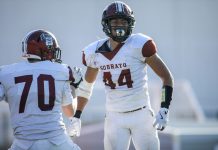As a kid growing up in Morgan Hill, Tony Sordello remembers
walking or riding his horse three miles both ways to watch sports
at Live Oak High. A few years later, he and his buddies
– Gus Bonaccorso, Bill Robinson, Al Gallardi and the Mulch
brothers, Johnny and Charlie – played the lone sport at Live Oak
High in 1943. It was during World War II and tiny Live Oak’s sports
were curtailed by war rationing. There simply wasn’t enough gas to
make the regular trips to play ri
vals Los Gatos, Mountain View and Campbell Union. Two decades
later, Sordello’s nephew Gene Guglielmo played just about every
sport there was at Live Oak, including on the first-ever league
championship Acorn football team and the league champion basketball
team in 1966.
As a kid growing up in Morgan Hill, Tony Sordello remembers walking or riding his horse three miles both ways to watch sports at Live Oak High. A few years later, he and his buddies – Gus Bonaccorso, Bill Robinson, Al Gallardi and the Mulch brothers, Johnny and Charlie – played the lone sport at Live Oak High in 1943. It was during World War II and tiny Live Oak’s sports were curtailed by war rationing. There simply wasn’t enough gas to make the regular trips to play rivals Los Gatos, Mountain View and Campbell Union.
Two decades later, Sordello’s nephew Gene Guglielmo played just about every sport there was at Live Oak, including on the first-ever league championship Acorn football team and the league champion basketball team in 1966. Twenty years later, Guglielmo was inducted into the Live Oak Hall of Fame.
On Sunday, the 80-year-old Sordello and the 56-year-old Guglielmo will be among the former Acorn athletes in attendance at the Live Oak High School Centennial celebration, links to the school’s long and storied sports history.
From the first half of the 20th century, when the little town of Morgan Hill produced just enough students for a small but hearty band of athletics teams, to the beginnings of a winning tradition in the 1960s, to the 20-year dominance of the 1980s and 1990s, Live Oak High sports have undergone massive change since the school’s early days.
In 1908, Oak Leaves “Athletics Editor” Frank Barnhardt bemoaned his classmates’ “lack of enthusiasm and school spirit,” which resulted in just a single athlete – miler Thomas Rootes – competing for the new school. Rootes took second in the mile at the brand new Interurban Athletic Union meet. Barnhardt swore the school would do better in the future.
Live Oak did manage to purchase new tennis courts, paid for with the proceeds from a student-produced “entertainment” – a harbinger of modern fundraisers to come.
By 1914, the Acorns had fielded a “basket ball” team, which lost to Campbell Union in the league championship game, and a IAU tourney-winning tennis team featuring stars Herbert R. Schulz and Claire Carlyle.
There was a general dismay about the lack of girls interested in athletics despite their seeming as “husky” as girls from other schools.
In 1926, Live Oak had moved into the Peninsular Athletic League, and had added several girls sports, although they were limited to “inter-class” competition.
By 1938, the Acorns had moved into the Santa Clara Valley Athletic League and assembled nearly a full compliment of sports teams, at least for the boys. Girls were still largely limited to interclass sports. Live Oak speedster Harold Davis gained renown that year by setting league records in the 100-yard dash (9.7 seconds) and the 200 (22.0) for the Acorn “cindermen” (so named for the cinder tracks used in those days).
In 1948, a new day dawned at Live Oak, which added new lighting, bleachers, uniforms and the crowning achievement – a new electric scoreboard – to its athletic facilities.
That year, varsity basketball captain Ray Gwinn was celebrated for making the all-league team.
And, the Girls Peninsula Athletic League was formed, elevating girls sports to new competitive levels.
In 1958, Coach Ami Leso and captains Joe Ciraulo and Kenneth Brock led the Acorn football team.
Then, in 1966, Live Oak broke through with its first league title (having moved to the MTAL by then), going 8-1 overall behind all-leaguers Bill Pelleschi, Ed Ferri, Ruben Escamilla, Jeff McGrew, Kim Moreno and more. Coach Duane Asplund’s basketball team also took a league title, compiling a 21-5 overall record. In cross-country, Nick Wray won his second straight league title and a section crown, too.
Meanwhile, aquatics coach Tim Thornton assembled the school’s first water polo team that year, beginning a long run of dominance in the sport at Live Oak.
By 1978, with new assistant coach Norm Dow, had qualified for its first trip to the CCS playoffs after finishing in a three-way tie for first in the Santa Teresa Athletic League.
And, Olympic swimmer Kelly Asplund was just realizing her potential under her coach, former Olympian Lynn Gautschi.
Next week: Live Oak enters a new era of dominance in sport in the 1980s.







